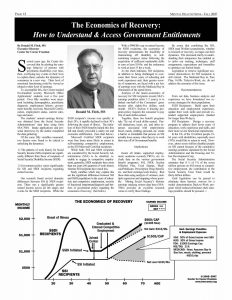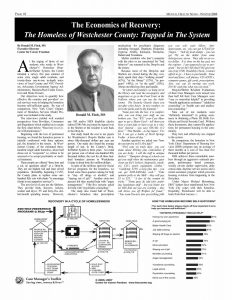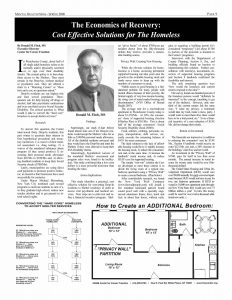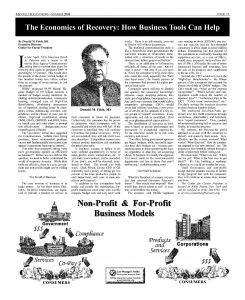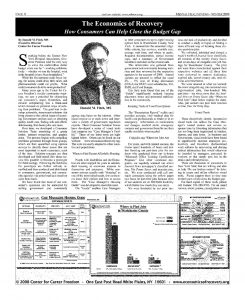Acknowledgements
This Sourcebook is dedicated ot the over fifteen-hundred persons at the Center who suffer from mental illness; Depression, Schizophrenia, Bi-Polar Disoreder, Borderline Personality Disorder and, alocohol and/or substance abuse.
The research studies and Case Manager’s tools contained herein are the direct outgrowth of the anger, frustration and tears our recipients expressed during intake interviews over a ten year period.
I would like to thank the Center’s Board of Directors for their counsel and support:
Ira Minot, LMSW, Chairman, Steven H. Smith, PsyD. Vice Chairman,
Jamins Lauria, BBA, Treasurer and Sondra Borek, Secretary.
To my Assistant, Joanne Casablance, to our excellent Graphic Artisit, Michael Zemaitis and to my son Thomas for providing internet access to thousands of persons in need.
Introduction
The objectives of the Sourcebook are three fold.
- To shape the agendas and resource allocation decisions of our system’s leadership,
- To provide concrete tools to the folks in the trenches of direct care; the professionals and their recipients*
- To stimulate academic researchers to verify and expand upon the Center’s Consumer Suverys
Most people’s agendas are predictable, pharmaceutricals want more profits, officials want to be reelected, unions want better jobs, professionals; less paperwork, Government bureaucrats; mroe rules, academics; tenure, but what do recipients want? Better meds? Better Therapists? A cure?
Our recipient’s questions led us to initiate a series of in-house research projects, ten of which have been summarized here. Our research objectives are always the same: to identify and quantify those issues which are most important to most recipients, most of the time.
* If you are reading online, you are probably in the trenches
We believe if we can prioritize their issues, we can make the case for a better alignment of the system’s resources. We believe until Government and non-profits accept that the ultimate success or failure of any program lies with the consumer, they will continue to waste time, money and lives
But, simply quantifying the problem is not good enough – what is needed now are new, innovative, cost effective solutions.
Following a cure for mental illness, recipients told us they needed solutions on how to get more money – both from the Government and themselves – thru work skills training and employment.* And while the Center offers some fifteen classes a week of Microsoft Office Training, we felt we could do more. We needed to help find practical, inexpensive solutions.
The solutions we created, which we call “The Case Manager’s Toolkit”, are a collection of ten tools which educate and empower the recipient to access their benefits, better manage their disability and promote their recovery.
* In order for a recipient of SSI or SSDI to become self-sufficient, they need sufficient work skills to earn $15/hr and the stamina to work thirty-five hours/week.
While copyrighted permission is given to Community Agencies to adapt the tools to their own counties and populations.* Academic researchers are encouraged to replicate our Consumer Surveys (most of the questionnaires are available at our website).
We invite suggestions for future tools and research and to become a part of our online community through subscription.
All tools and research projects contained in this Sourcebook were privately funded.
* A few hours of research is all that is required to specify the local phone numbers and benefits rates, you will not need a grant or committee
Table of Contents
Case Manager’s Toolkit
Benefits Poster -7-
Benefit Referral Cards -9-
Guide to Government Benefits -11-
Form-Link -13-
IEP Worksheet -15-
Employment Opportunities -17-
Where the Jobs Are -19-
Prescription RX Card -21-
The Privacy Wall -23-
Housing Guide -25-
Consumer Research
Consumer’s Top Ten Problems -28-
Disability Maps -30-
Life Cycles of Persons Receiving SSI & SSDI -33-
Cycle of Recovery for the Homeless -35-
Importance VS. Satisfaction Recovery Factors -37-
The Benefits of Computer-Based Training -39-
Computer Assisted Rehabilitation Program -41-
Consumer’s Perceptions of Providers -43-
Prioritizing Consumers Needs -45-
Inpatient Tracking Survey -47-
Mental Health News Columns -50-
Appendix -55-
Case Manager’s Toolkit
This colorful reception area poster (24’x36′) educates people-in-need about the critical services available to stabilize them in the community.
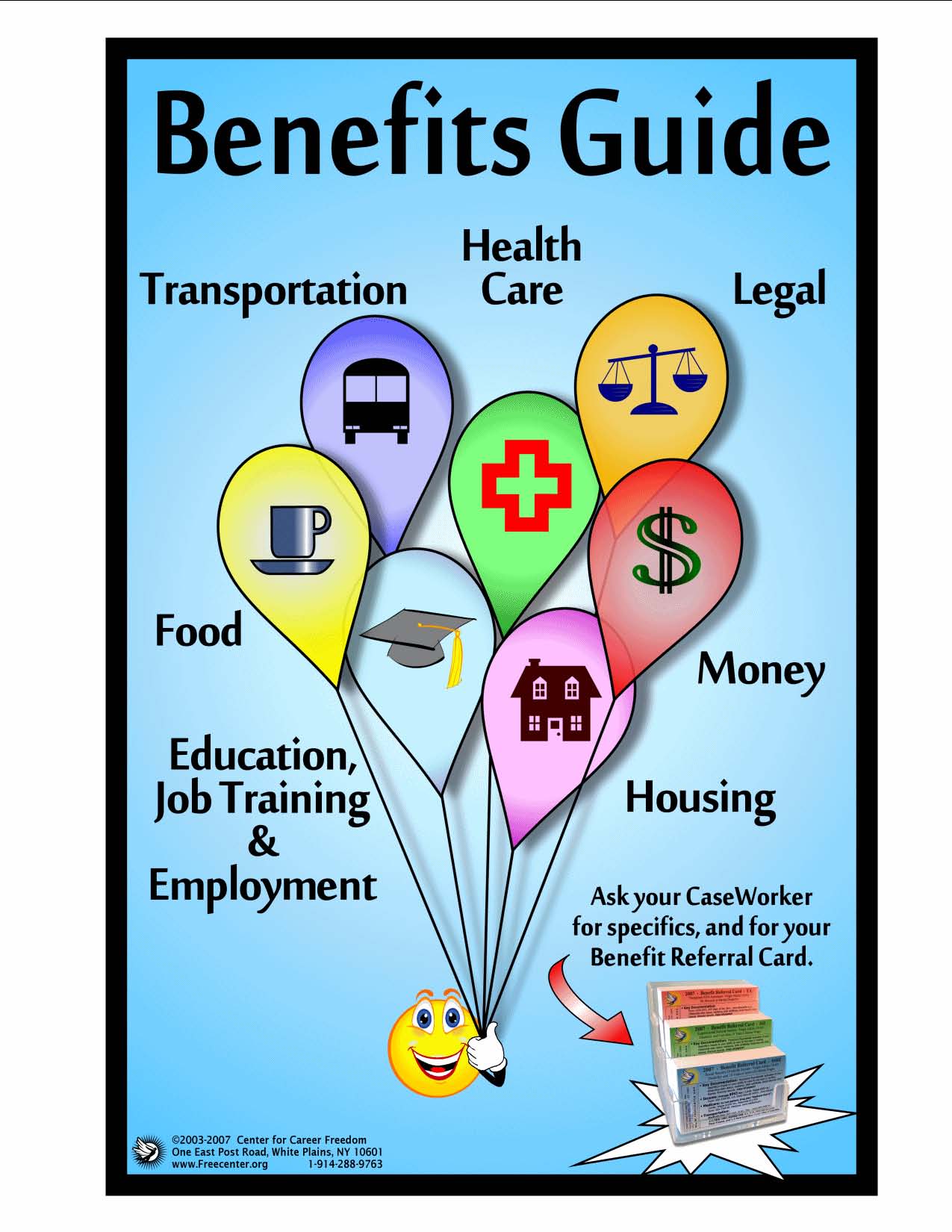
The Benefit Referral Wallet Card answers the important questions:
- Am I eligible?
- How much is the benefit?
- What documents do I need?
- Where do I go to apply?
- How much can I earn before I am cut-off?

The Guide to Government Benefits is a hard copy portable Case Management aide summarizing the essentials of some thirty Government benefits programs for single adults living alone who may be eligible to receive SSI, SSDI, TA (welfare), Medicaid, HUD, and more.
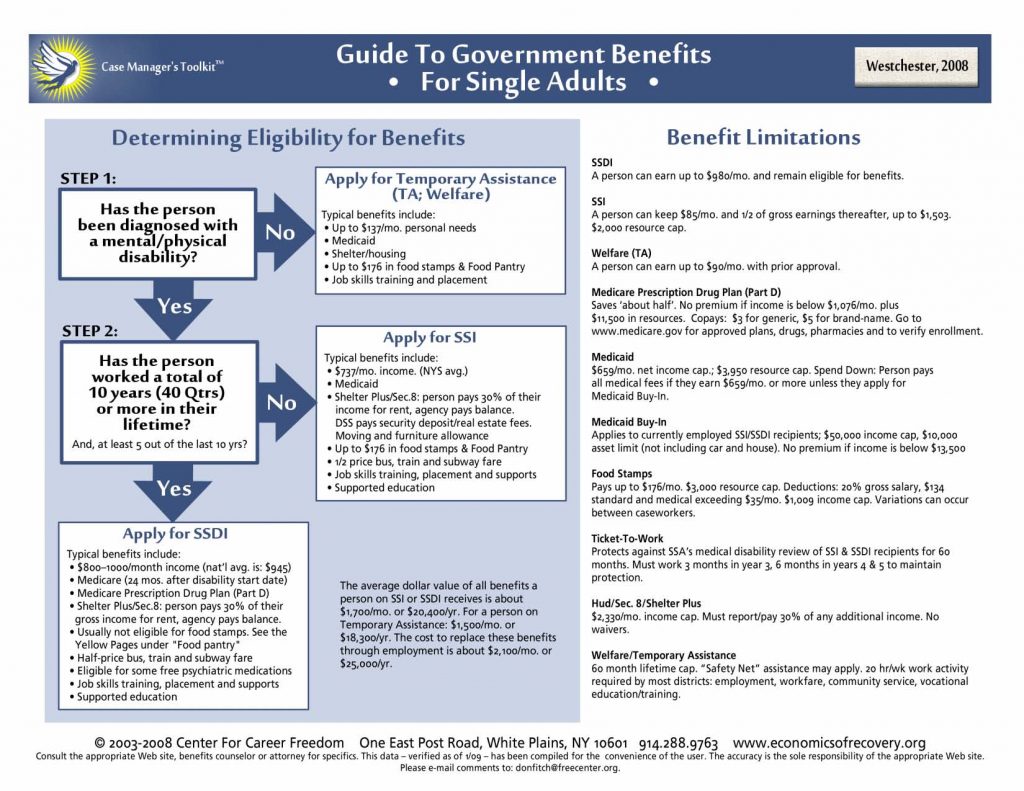
A compilation of over five hundred Federal, State and local application forms, Form-Link enables the Case Worker to immediately access the official Government forms to begin the application process, saving time, money and lives.

The Individual Employment Plan is a summary worksheet enabling the Counselor to create the specific steps required to reach the job goal.

This summary of over fifty Employment Opportunities from the NYS Department of Labor’s “Workforce New York – 2005 Data Base,” includes average earnings, qualifications, working conditions, and outlook. It helps the Case Manager and Consumer to clarify job choice.

The www.craigslist.org site contains hundreds of full and part-time jobs–ten times more than the Journal News or Penny Saver, (the rate$ explain the data). And, job seekers can post their resumes online, free for thirty days.

The “Prescription Record” wallet card provides accurate, vital medical data for health care professionals at intake or in an emergency. Information on medications and dosages, medical alerts, emergency contacts, and government benefits are then readily available when needed.

While the obvious solution for homelessness is a home, accessing permanent supported housing can take years and, the growth in the available housing stock and funds never seem to keep up with the numbers of consumers -in need.
The ideal solution to the lack of affordable housing would be to 1) rapidly increase the housing stock, 2) reduce the consumers’ rent, 3) increase the landlord’s rental income and, 4) reduce HUD’s cost for supported housing.
The simple “win-win” solution the Center developed to meet these criteria is to divide the living room of a typical one bedroom apartment using a “Privacy Wall” to create a second bedroom.

The “Guide” enables Case Manager’s to refer Consumers to up to eight housing options. It summarizes the essentials: eligibility criteria, key services, monthly rent, average wait time, and where to apply. Required documentation and earned income caps are included on the reverse side.
Our field tests found that use of the “Guide” significantly reduced housing placement time and promoted stabilization in the community.

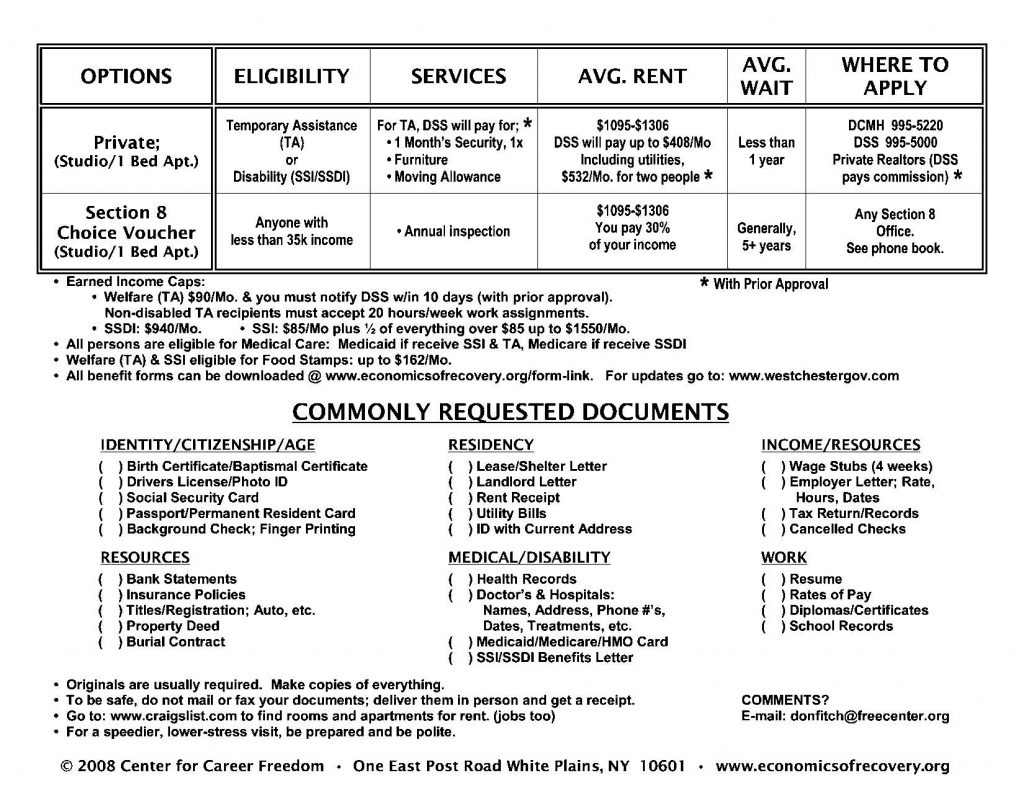
Contrary to popular belief, identifying and prioritizing Consumer’s needs can be a simple two-step process; first, compile a list of their needs at your next community meeting. Then, have them rate their needs on importance using a self-administered survey.
The result is a short list of needs that are most important to most of your Consumers. The challenge is to “solve” the problems. (Thirty minutes of Googling can often uncover programs that have stood the test of time).
In our research into the “top ten problems of Consumer’s”, the common theme was “not having enough money.” Several solutions were enacted; a part-time Job Development Club, expansion of our food and clothing donations and a Money Management Seminar.
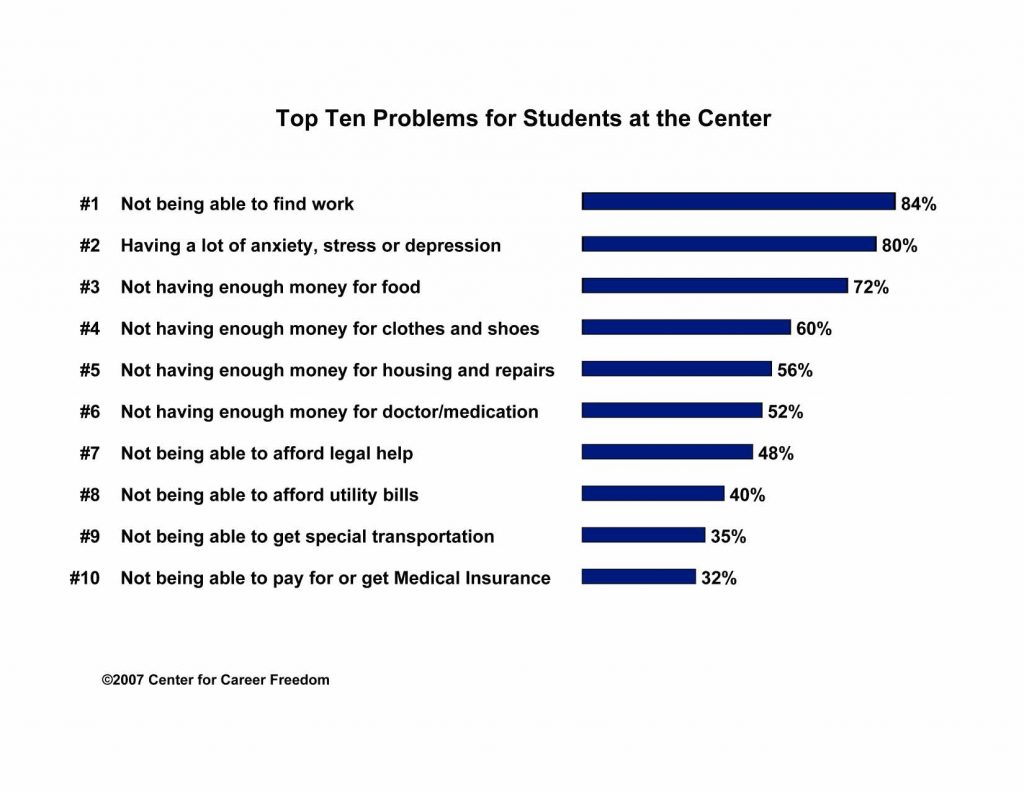
The Center pioneered the first maps showing the distribution of adults with psychiatric disabilities by zip code, in New York State. The data was derived from Social Security’s database of persons receiving monthly SSI and/or SSDI disability checks.
The primary application of these data is the location of critical services —to efficiently align the caregivers with those in need.
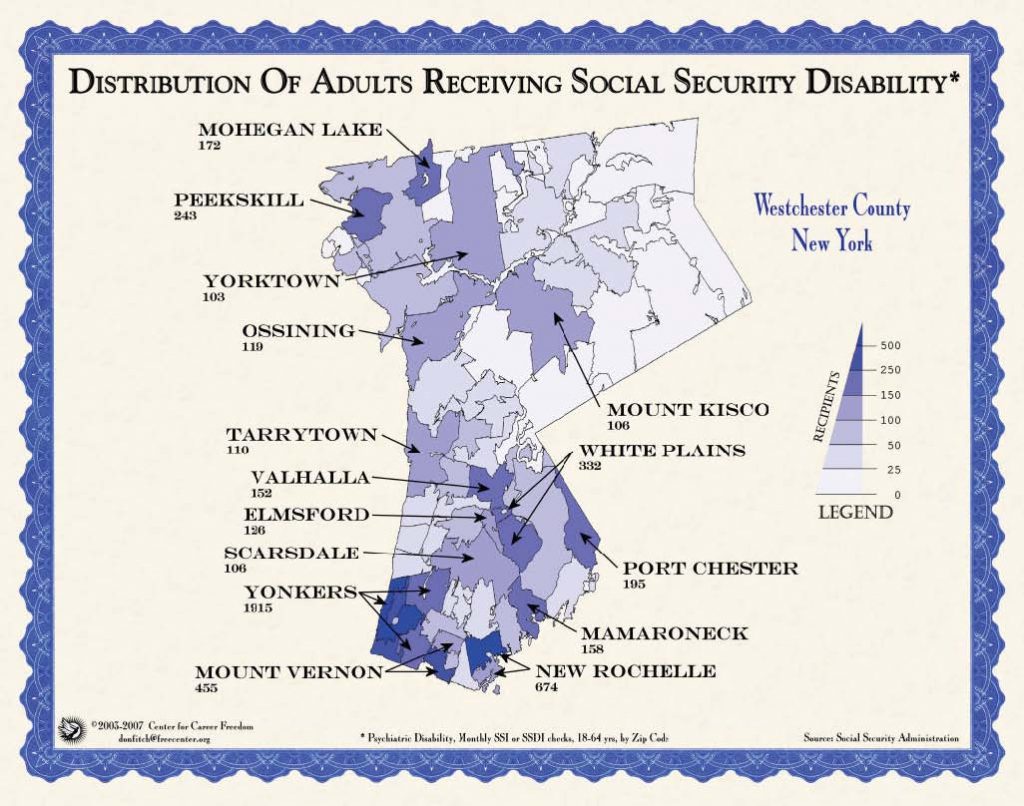
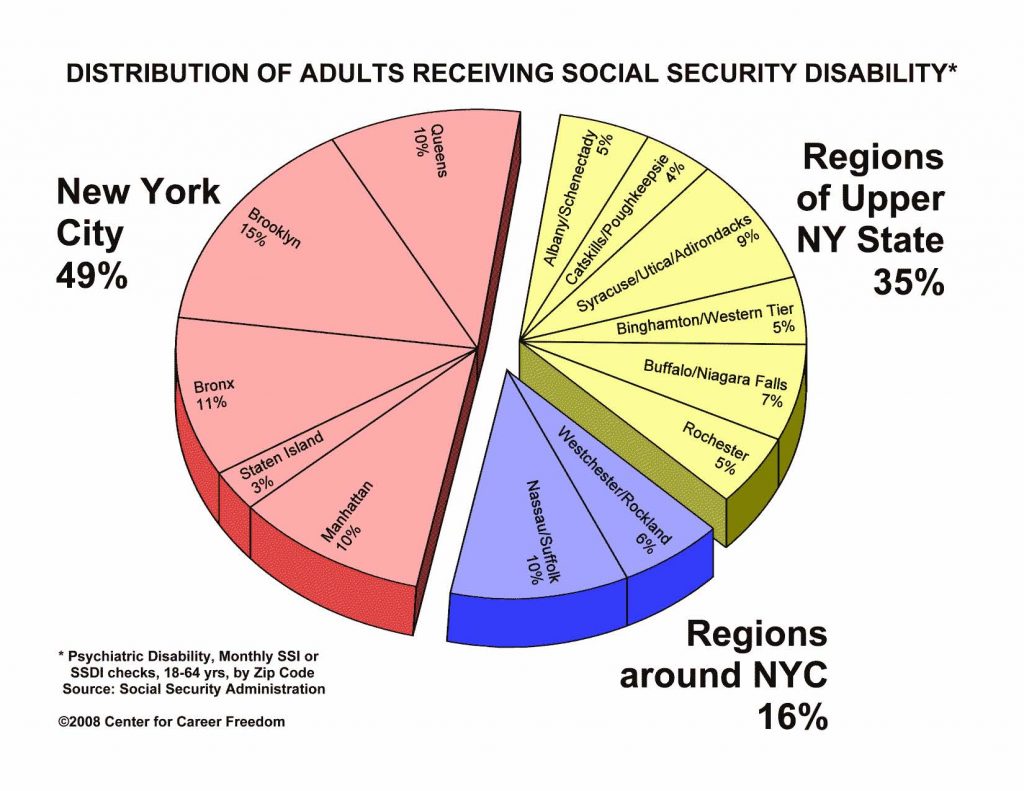
In the US, of the ten million people 18-64 years with disabilities, reportedly most (70%) would like to return to work. However, about seven million disabled people on SSI cannot because of the cumulative earnings penalties stipulated by the Social Security Administration and the Housing and Urban Development Corp. (HUD)
The Social Security Administration estimates that if ½ of 1% of the seven million persons on SSI return to competitive employment, the contribution to the Social Security Trust Fund would be thirty-billion dollars.
From our data, business analysis and experience we have formulated two recovery strategies for these populations:
- SSDI Recipients: Build upon their education and employment experience, update their work skills and provide extended supported employment, (funded for longer than 90 days).
- SSI Recipients: Design a recovery program to address their fewer years of education, work experience and skills, and their more severe functional impairments.
Until legislation can be passed to eliminate these barriers, waivers for a model demonstration Back-to-Work program which reduces/eliminates the earnings penalties should be established.
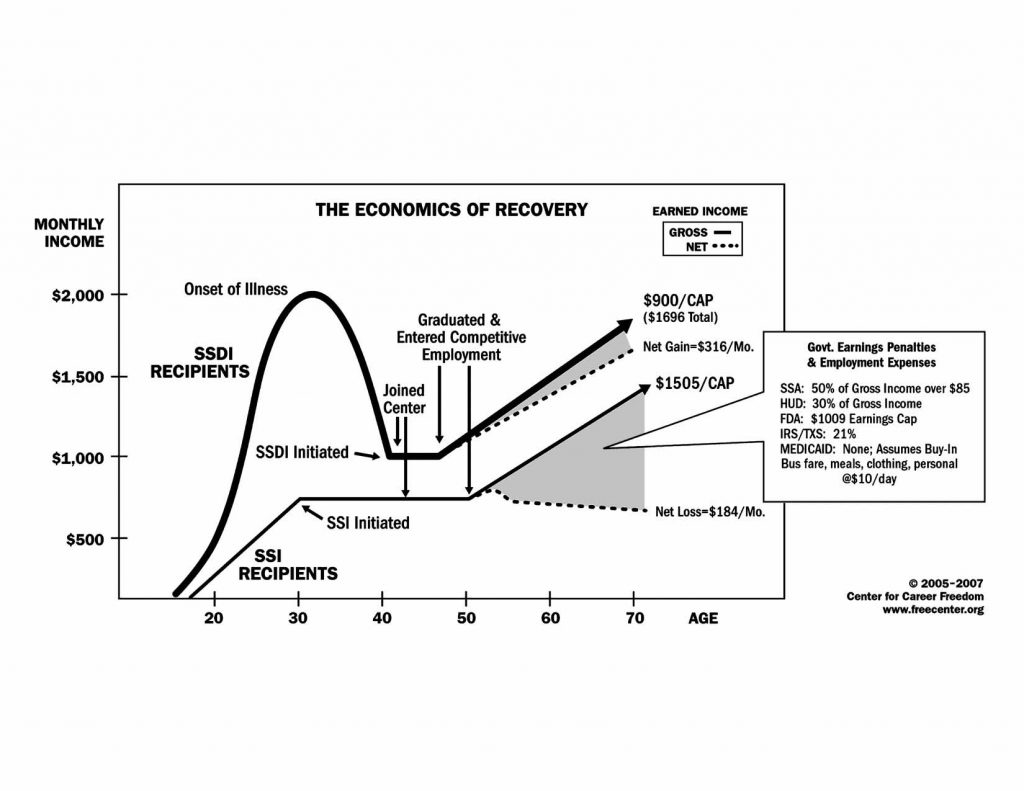
At the urging of those of our students who reside in Westchester’s Homeless Drop-In/Shelter System, the Center initiated a survey of some ninety single adult residents including, twenty-three interviews with local County and NYC Providers, Advocates, Government Agency Administrators, Business/Real Estate Executives, and Home Owners.
Our objective was to quantify how effective the counties and provider’s social services were in helping the homeless become self-sufficient again.
The interviews yielded well-rounded perspectives from Providers, Consumers, and Regulators which enabled us to create the flow chart below.
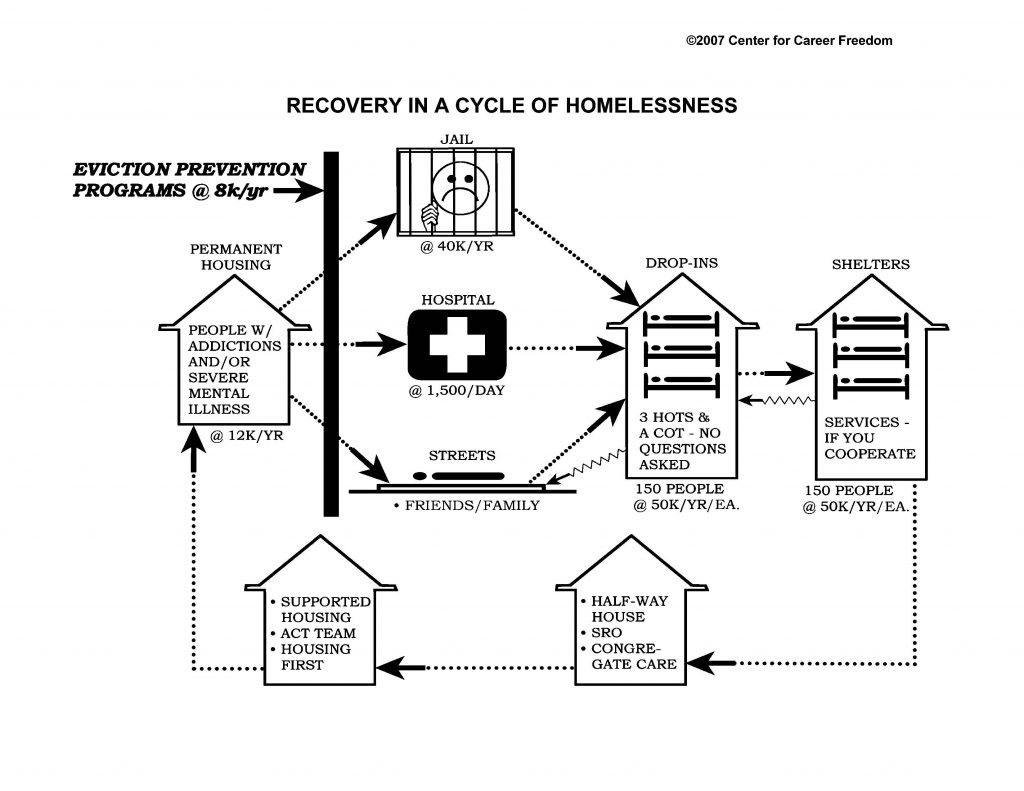
Our research among hundreds of Center applicants has found ‘satisfaction’ to be an inflated measure. All of the applicants to the Center’s Microsoft Business School said they were ‘very or somewhat satisfied’ with the program even before they enrolled (The measure may be a good fundraising tool, however).
When Consumers rated sixty-five items on both satisfaction and importance, 97% of the Consumers rated ‘my earning power’ as ‘very important to my recovery’ yet, only 15% were ‘very satisfied’ with their earning power, a gap of 82 points. We believe this gap offers a programmatic opportunity.
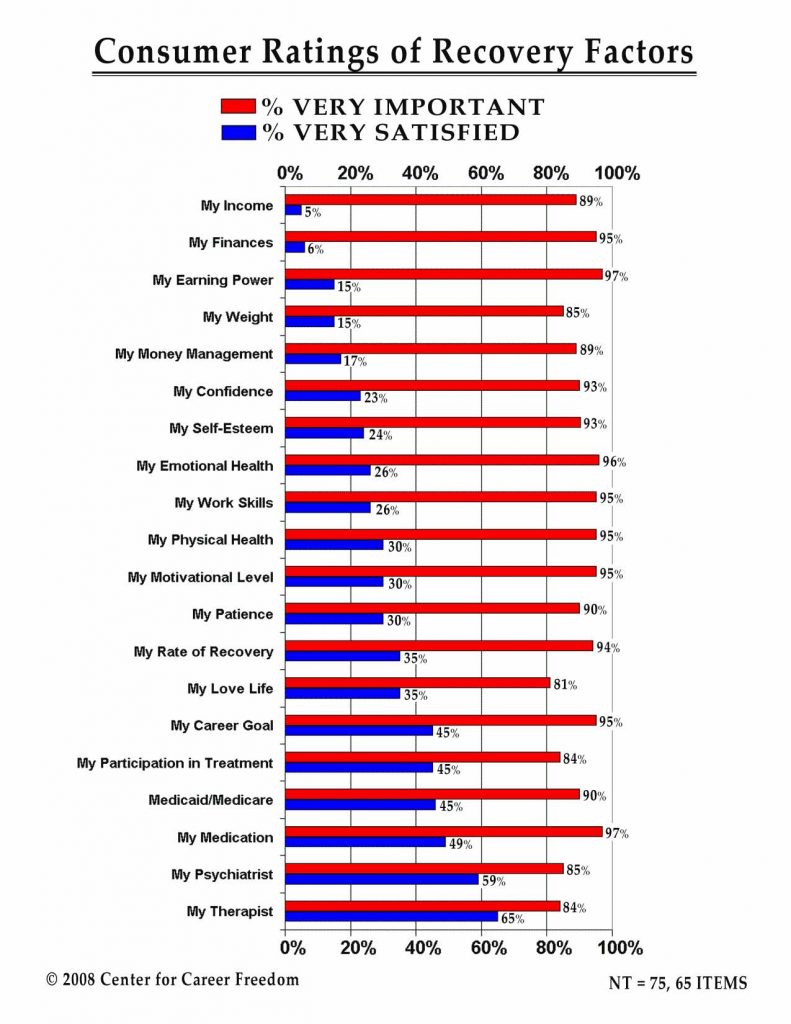
Research has demonstrated that people with mental illness, e.g. Schizophrenia, Bi-Polar Disorder and Depression often experience problems with attention, memory, response speed and problem-solving. And, these people are more likely to be unemployed or underemployed. (1)
A decade ago, it was believed that a “Work First” program was more effective than a “Train First” program in getting people back to work.
However, subsequent research has found just the opposite when Computer-Based Training is included in the program; patients scored thirty-two percent higher on cognitive functioning.
1) “Dealing with Cognitive Dysfunction Associated with Psychiatric Disabilities: 2002 OMHWEB/COGDYS
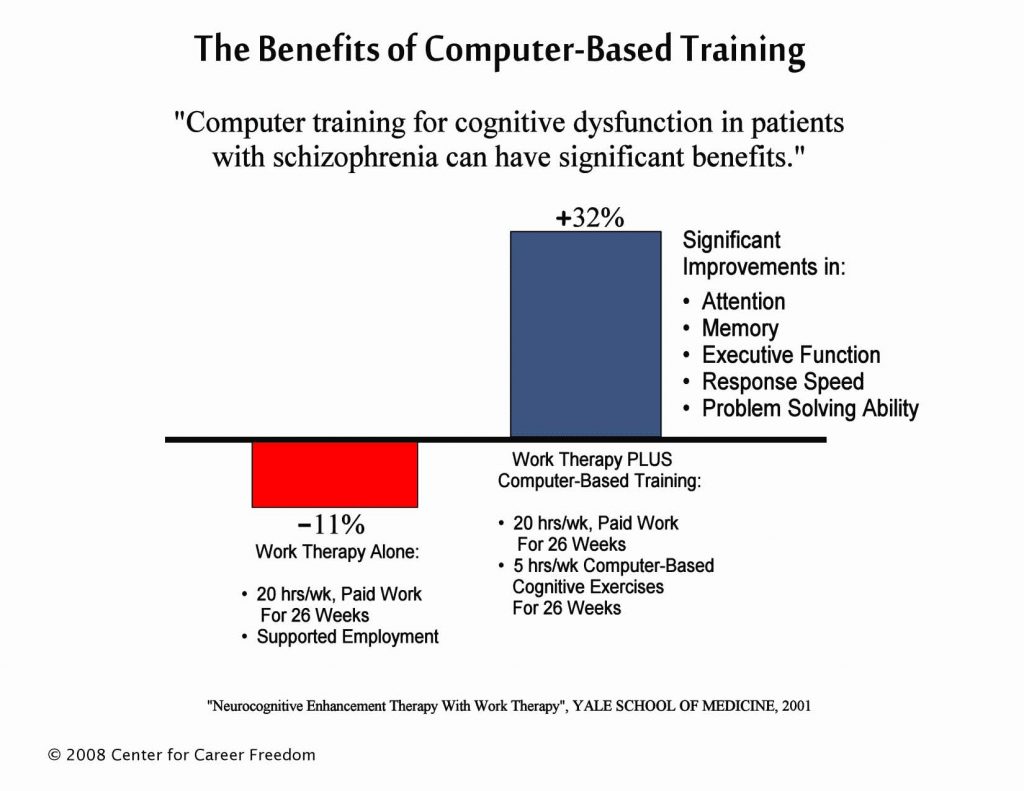
The Center’s Computer Assisted Rehabilitation Therapy Program evolved from our efforts to certify some one-thousand five hundred SPMI persons on Microsoft’s Office Applications Program; Word, PowerPoint, Excel, etc. Classroom settings have ranged from long-term inpatient hospital Units to CDT’s, IPRT’s, Out-Patient Programs and Drop-Ins.
Interestingly, we found the student’s interests in and ability to assimilate the four components charted below varied by their setting or, continuum of care. Inpatients gravitated towards the Video Games and WII while IPRT thru Drop-In Participants showed a greater interest in acquiring Microsoft Office Certification.
The Case Manager’s Toolkit was accessed most often by Discharge Planners, Social Worker’s, etc. in resettling the recipients back into the Community.
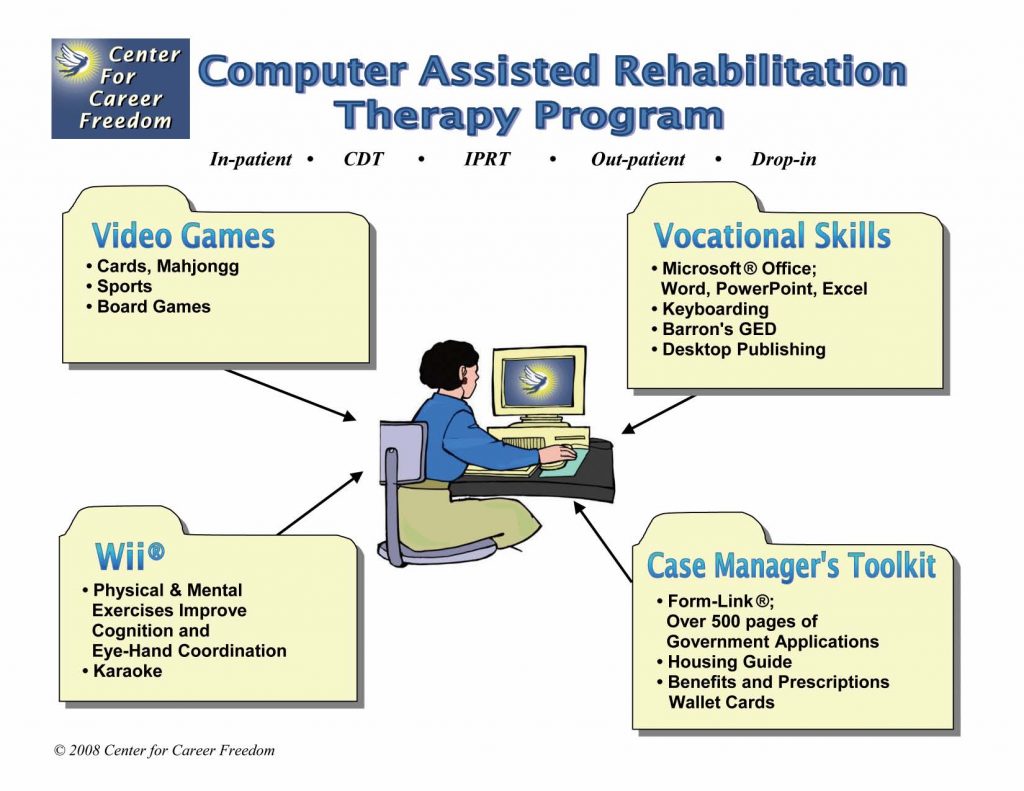
In politics and business, consumer research has demonstrated a link between how people perceive a political candidate or a product spokesperson, and how they cast their vote or spend their money.
We wondered what our Consumer’s ‘ideal’ Psychiatrist, Therapist and Case Worker might look like? And, what words they would use to describe them?
Drawing upon our years of consumer research experience for Madison Avenues largest advertising agencies, we gave twenty-five consumer’s a set of nineteen 8×10 photos to sort by their degree of association to each job title. We then gave them a deck of forty-seven cards with various attributes on them and asked them to place the card on the appropriate photo, or not.
The results for the top three and bottom three photos were charted along with these attributes most associated with the photo.
As professional advice goes, the pilot study reinforces the importance of a smile and paying attention to your client.
Interestingly, the big winner, the Psychiatrist, Looks a bit like Dr. Phil.
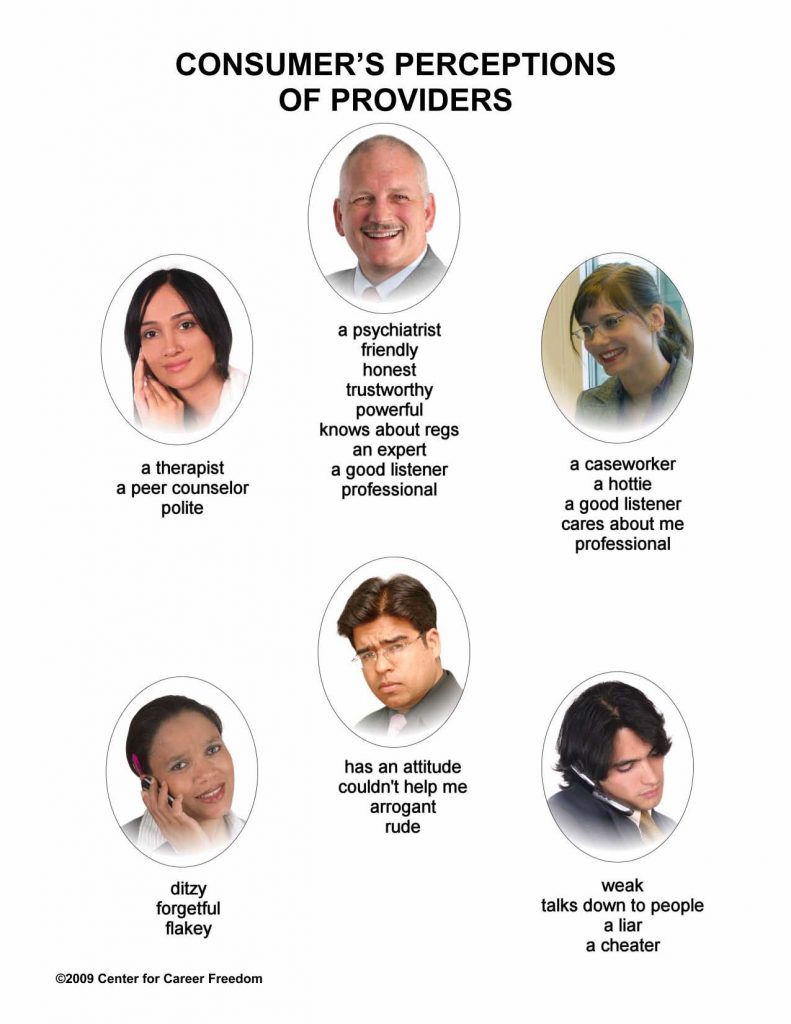
Instead of convening big meetings to wrangle over which issues to allocate precious time and money, for-profit businesses move forward rapidly and efficiently because they already know what their Consumers need.
Sound Consumer research marginalizes the political pushing and shifts the focus to the quality of the ideas. A new paradigm emerges; real debates about real solutions. Suggestions based on personal prejudice and guesswork will not survive factual, transparent collaboration.
The Center’s meta-analysis of over two-hundred-fifty factors among hundreds of Consumers identified eight that Consumer’s said were “very important to my recovery” and they were “least satisfied” with. These are the priorities Government and Community providers need to address.* To the Consumer, the “most satisfied” factors in the first column have been achieved.
These are success stories. Congratulations.
*However, the Consumers’ priorities are often not the same as those of the organizations that purport to represent them. More alignment is required.
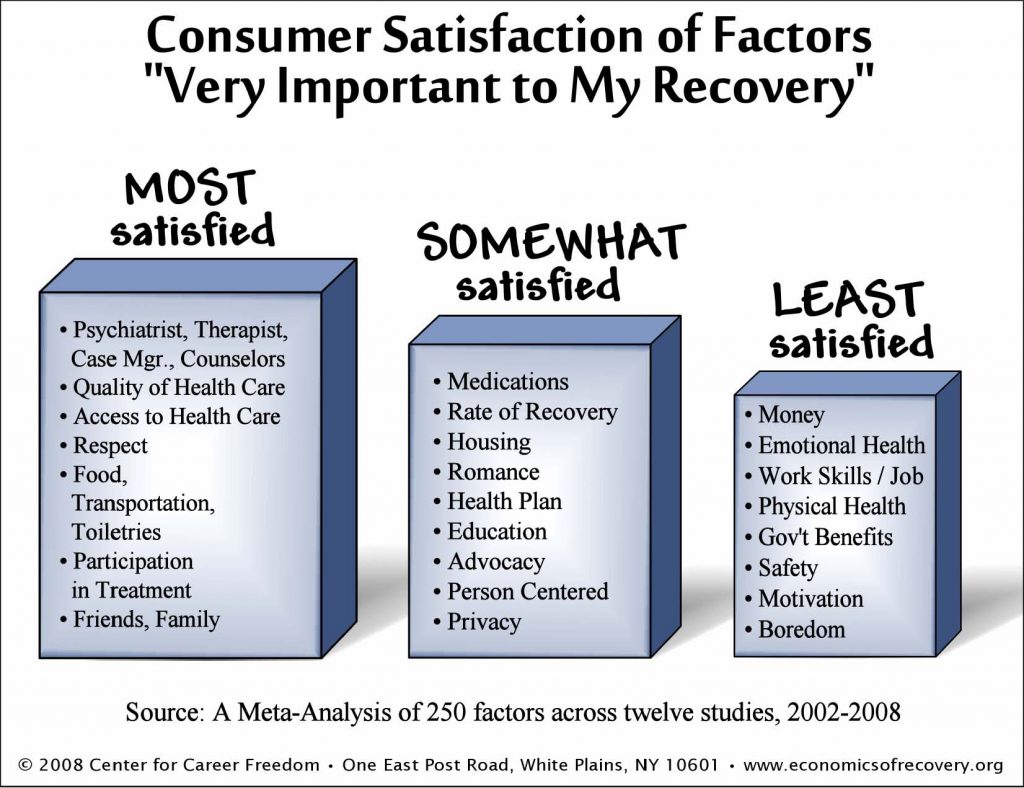
The most serious research project the Center has initiated to date is to quantify the Consumer’s in-patient experience. Our objective is to share our confidential findings with providers and Regulatory Agencies to achieve targeted system reform.
This ongoing national tracking survey grew out of the over one thousand five hundred one-on-one intake interviews at the Center these past ten years.
Stories of in-patient abuse, especially among young women, were frequently reported – yet, formal complaints, criminal charges, lawsuits or published studies were rare. These victims were being punished by their own and the system’s silence. The “elephants in this room” are toxic; the failure to report and correct these crimes perpetuates and deepens the tragedy .*
After consulting legal counsel, we initiated a three-part data collection strategy; at intake, direct mail and online (www.economicsofrecovery.org/inpatient survey) in the Fall of 2008.
Early results show that over ninety percent of the recipient’s inpatient experience is positive and professional. However, unresolved issues include a lack of privacy, safety, and trust. Five to ten percent reported incidents of verbal, physical or sexual abuse.
*Some caretakers have argued that some inpatients are delusional – who are you to believe?
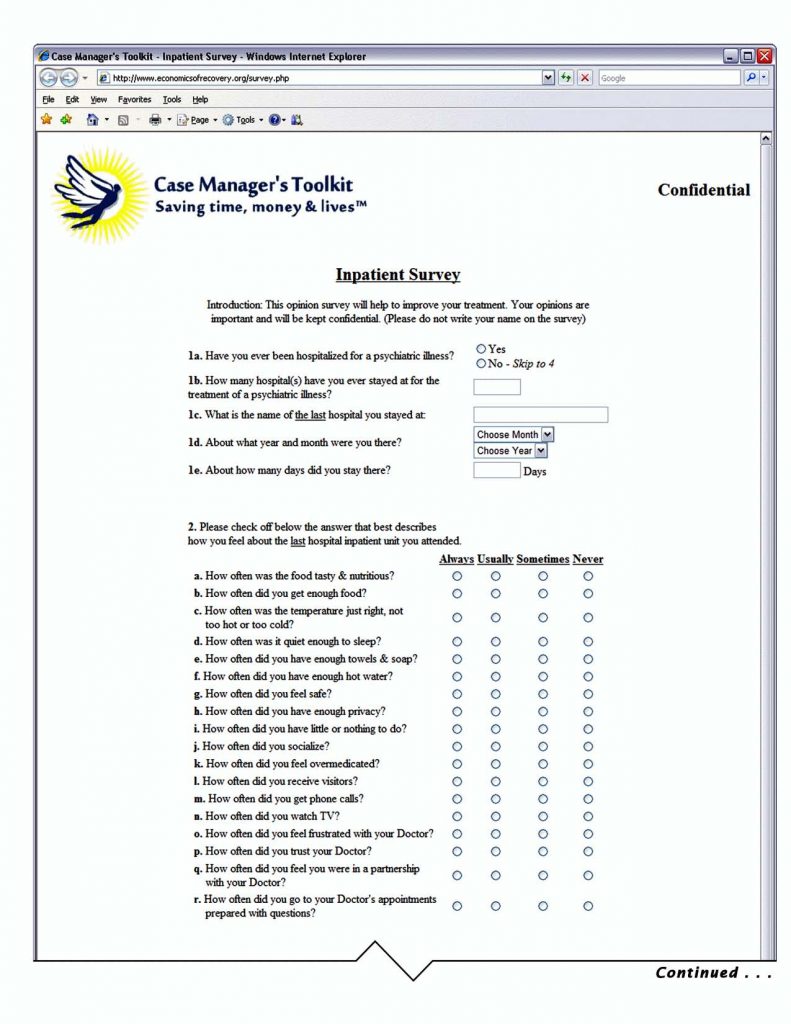
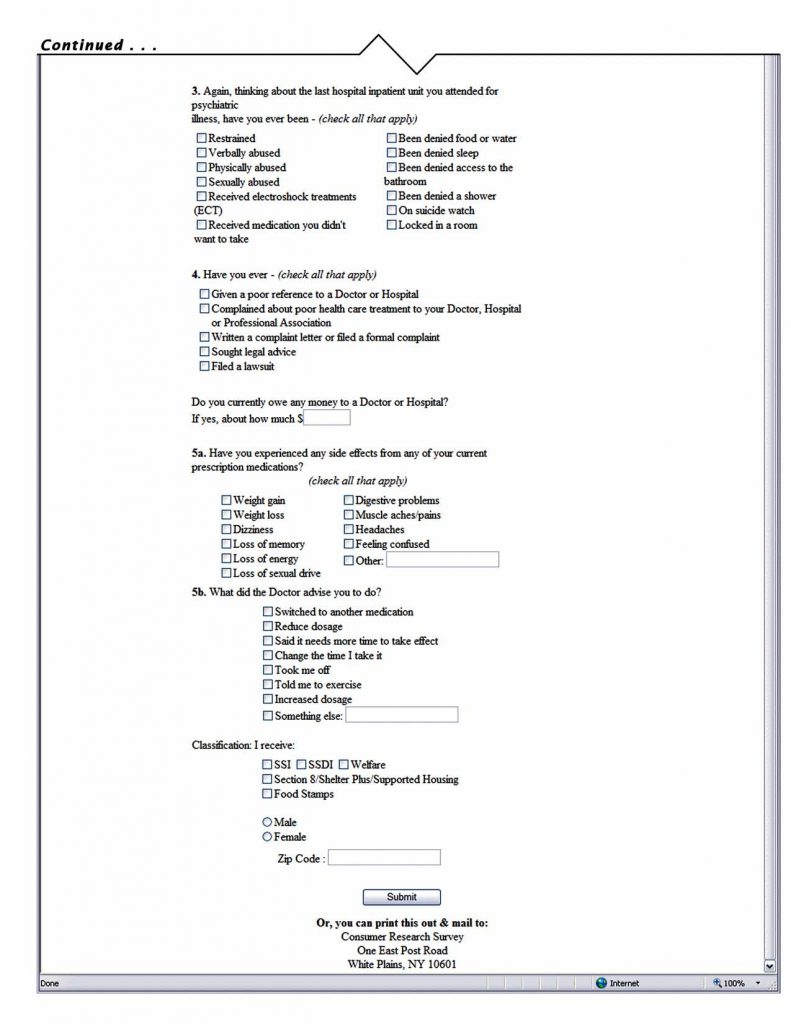
Mental Health News Columns
Appendix
About the Center
Founded in 1998, The Center for Career Freedom is a grassroots 501 (c) (3) non-profit corporation with a mission of rehabilitation and recovery of persons with psychiatric disabilities leading to competitive employment. The Center is the only non-profit in New York State that is a licensed Business School by the NYS Department of Education, Microsoft © Certified Office Specialist Training Center and 100% recipient run.
All staff are survivors of mental illness and must have experience in business, counseling, and teaching. This unique blend of skills provides students and members with a caring and street-smart approach to reaching their goal of self-sufficiency.
With fourteen staff and volunteers, the Center has assisted one-thousand men and women throughout Westchester County, NYC, and NYS. Benefits and economics of recovery research is provided to thousands more through Don Fitch’s quarterly column in Mental Health News (100k readers in the tri-state area) and the Center’s three websites;
www.freecenter.org, www.casemanagerstoolkit.org, www.economicsofrecovery.org
The Center’s pioneering research reports are distributed each year to local, state(s) and federal government agencies, legislators, universities, peer and non-peer community agencies, professionals, consumer and family associations, private and corporate foundations, leading newspapers and academic journals. Expenses associated with the development and distribution of these reports are provided pro bono.
Donald Marden Fitch, MS, Founder, and Executive Director
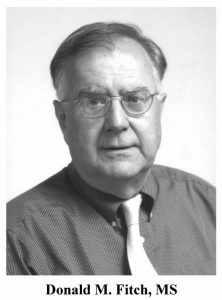 Don (68) earned his B.A. in Psychology from N.Y.U.’s College of Arts and Science and a Masters in Counseling from L.I.U. He interned at St. Vincent’s Hospital, Westchester.
Don (68) earned his B.A. in Psychology from N.Y.U.’s College of Arts and Science and a Masters in Counseling from L.I.U. He interned at St. Vincent’s Hospital, Westchester.
His non-profit experience spans twenty years in administration, fundraising, consultation, and direct care. Populations served to include persons with mental and physical disabilities, substance abusers, children in foster care, the elderly, persons with HIV/AIDS and others.
Don also spent twenty years in the for-profit sector as a Marketing Consultant for such companies as IBM, Toyota, General Motors, Xerox, Colgate-Palmolive, Coca-Cola, KFC, J., Walter Thompson, and others. He was a Manager in the Marketing Department of Pepsi Cola Company in Purchase for five years and their Marketing Consultant for many years thereafter. Don is a Vietnam era Veteran, a father of three sons and a grandfather of five granddaughters.

